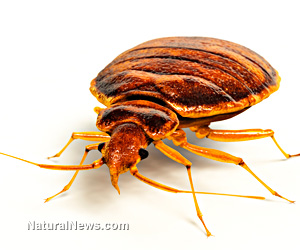
The bean plant leaf traps and kills bed bugs
Sunday, June 02, 2013 by: Antonia
Tags: bed bugs, insecticide, bean leaves
Most Viewed Articles
Today
Week
Month
Year
- Newly released JFK files reveal Pentagon's role in creating Lyme disease and covid in the same lab
- Discovery of vast underground city beneath Giza pyramids challenges human history
- Black cumin seed oil emerges as a powerful ally against breast cancer and chronic inflammation
- Kiss Your Genetic Privacy Good-Bye! 23andMe Gets Green Light to Sell Your Intimate Genetic Details to Anyone They Want
- Sugar-free deception: Artificial sweeteners hijack hunger signals, fuel obesity epidemic, study warns
- Catastrophic 7.7 earthquake devastates Myanmar and Thailand; death toll could reach 100,000
- AI breakthrough slashes celiac disease diagnosis time from months to minutes
- Europe braces for WAR as EU urges citizens to STOCKPILE FOOD, in latest provocations with Russia
- Aluminum pollution: A silent threat to human health
- Thomas Massie’s Dual Loyalty Disclosure Act aims to restore American sovereignty by cracking down on foreign influence in Congress
- Dr. Suzanne Humphries makes bombshell appearance on Joe Rogan podcast, exposing vaccine industry deception back to POLIOMYELITIS
- The cancer fear industry: How big pharma profits from panic-and what natural alternatives offer
- The mighty Eggplant: An underrated superfood with ancient roots
- 200 Tesla showrooms bracing for Saturday protests as movement against Musk escalates
- Is the vaccine-autism debate reopening? Washington Post sparks controversy with preemptive hit piece on David Geier
- A handful of pecans a day could keep heart disease at bay, study finds
- Sweden's migrant crisis deepens as failed green energy venture leaves thousands jobless, exposes systemic collapse
- The great crypto power struggle: How technocrats and governments are reshaping global finance
- Newly released JFK files reveal Pentagon's role in creating Lyme disease and covid in the same lab
- Analysis: The coming economic collapse, a mass uprising and Trump's three secret weapons to halt the growing revolt
- Trump nominates VACCINE ZEALOT Susan Monarez to lead the CDC, sidelining RFK Jr.'s reform efforts
- Trump's greatest betrayal so far: Accelerating Middle East wars, silencing dissent, and serving Zionist masters
- Dr. Mike Yeadon releases 15-minute testimony - WATCH - about genocidal intent of COVID “vaccines”
- Festive flavors: The sweet history, nutritional profile and health benefits of pecan pie
- Elon Musk: Aliens could be here on Earth RIGHT NOW
- Big Pharma's $8 Billion bribery scheme exposed: how doctors are pushed to prescribe junk science, not heal
- 5 Simple steps to boost your brainpower: How to strengthen executive function in a distracted world
- Trump reverses course on Gaza plan, says “nobody is expelling Palestinians”
- A lack of integrity in Academia: Harvard professor found GUILTY of fraudulent research to promote CRT theory
- Reclaim your health: How midlife exercise reverses years of inactivity
- Survival 101: Effective EMF blocking techniques
- Florida takes a stand: DeSantis proposes permanent ban on mRNA vaccine mandates
- Sugarcane extract superior to cholesterol-lowering drugs?
- California's social media censorship law struck down: A victory for free speech or a threat to online safety?
- OpenAI whistleblower who dissented against how the company trained ChatGPT found dead
- EPA advisor admits the agency is funneling billions to climate groups ahead of Trump’s return to White House
- EPA advisor admits the agency is funneling billions to climate groups ahead of Trump’s return to White House
- Newly released JFK files reveal Pentagon's role in creating Lyme disease and covid in the same lab
- California's social media censorship law struck down: A victory for free speech or a threat to online safety?
- Dr. Mike Yeadon releases 15-minute testimony - WATCH - about genocidal intent of COVID “vaccines”
- The Health Ranger releases “Vaccine Zombie” song and music video, using AI-animated zombies for the music video
- The pandemic as a tool for INDOCTRINATION: Understanding “The Indoctrinated Brain” by Dr. Michael Nehls
- Florida takes a stand: DeSantis proposes permanent ban on mRNA vaccine mandates
- “Why we influenced the 2020 elections”: Facebook files reveal the coordinated effort to bury the Hunter Biden laptop story
- Mike Adams releases country western hit single: Goin’ Back in Time is Comin’ Home
- Mike Adams releases music poetry sensation: A Child of God
- Unpacking the Lies That We’ve Been Fed – new song and music video released by Mike Adams, the Health Ranger
- Michigan sheriff announces criminal investigation into 2020 election crimes, Dominion Voting Systems
- Migrants are taking advantage of recent hurricanes to scam residents and loot their homes
- House Intelligence Committee calls for the ARREST and PROSECUTION of Dr. Anthony Fauci
- RFK Jr. clears key hurdle: Sen. Susan Collins backs controversial HHS nominee, signaling a new era for health policy
- Rep. Nancy Mace introduces bill to ban biological males from female facilities on federal property
- Peter Rost exposes Big Pharma corruption in his book “The Whistleblower: Confessions of a Healthcare Hitman”
- Mike Adams releases new song and music video: Nothing More Disgusting Than a Globalist
- Red Cross issues warning to stop blood plasma donations from vaccinated people
- Scientists confirm: GENIUS brain function can be spontaneously unleashed in humans without any apparent cause
- EPA advisor admits the agency is funneling billions to climate groups ahead of Trump’s return to White House
- HYSSOP: What research reveals about the health benefits of this ancient holy herb
- Two containers with completed ballots fall out of truck in Florida
- Fully vaccinated about to see “tsunami” of illness and death, warns virologist
- Global leaders unite to clamp down on “misinformation” with UN-backed Cascais Declaration
- BREAKING: 2025 NDAA authorizes mandatory military draft of WOMEN across America… as Pentagon pursues global NUCLEAR war with both Russia and China at the same time
- Michael Yon warns of a ZIONIST TAKEOVER in Trump’s second administration
- BOMBSHELL: DNA testing kits are a SCAM to develop ethnic-specific bioweapons
- Ozempic and Wegovy weight loss drugs are injectable LIZARD VENOM PEPTIDES that may unleash a devastating wave of organ failure… side effects align with symptoms of SNAKE BITES
- Israeli soldiers accused of even more torture and abuse in the West Bank
- These 13 countries just signed an agreement to engineer a global FAMINE by destroying food supply
- NASA admits that climate change occurs because of changes in Earth’s solar orbit, and NOT because of SUVs and fossil fuels
- RFK Jr. clears key hurdle: Sen. Susan Collins backs controversial HHS nominee, signaling a new era for health policy
- Sermon 30: How Jesus reveals Caesar’s FAKE CURRENCY and FALSE AUTHORITY
- Coriander seeds: Ancient medicine backed by modern science
- Arizona officials claim Maricopa County needs 10-13 days to tabulate results of the election
(NaturalNews) Bed bugs may soon become a more manageable pest, as they may fall victim to new science that mimics bean plant leaves.
Bed bugs live in beds as you might have guessed. They hide during the day and feed on the blood of humans at night. Tens of millions of dollars are spent annually in New York City alone to deal with these pests.
More than just the infestation of homes, bedbugs have been sucking the blood of victims in schools, movie theaters, and hospitals. They are hitchhikers, great hiders, and rapid breeders.
This remedy for bedbugs has been used for centuries by those in Bulgaria, Serbia and other Eastern European countries. They lay the leaves around the bed at night and as the bugs scurry across the floor to gain access to the victim, they end up "sticking" to the leaves. The leaves, in the traditional way of doing things, are then burned in the morning.
Default behavior to kill insects is to use poison. However with the shocking comeback of these bugs in recent years across the world, it suggests a resistance to the poisons.
There is an attempt being made to mimic the results of the "bean leaf trap" using synthetic material. The "hooks" on the leaf, called trichomes, essentially "stab" or "hook" the bugs and keep them from moving further.
"Plants exhibit extraordinary abilities to entrap insects," Loudon said. "Modern scientific techniques let us fabricate materials at a microscopic level, with the potential to 'not let the bed bugs bite' without pesticides."
With the synthetic technique, currently impalement does not occur, but some trapping does, so more work is to be done.
Sources for this article include:
scientificamerican.com
news.yahoo.com
https://www.naturalnews.com/030501_bedbugs_New_York.html
About the author:
A science enthusiast with a keen interest in health nutrition, Antonia has been intensely researching various dieting routines for several years now, weighing their highs and their lows, to bring readers the most interesting info and news in the field. While she is very excited about a high raw diet, she likes to keep a fair and balanced approach towards non-raw methods of food preparation as well. >>> Click here to see more by Antonia
Bed bugs live in beds as you might have guessed. They hide during the day and feed on the blood of humans at night. Tens of millions of dollars are spent annually in New York City alone to deal with these pests.
More than just the infestation of homes, bedbugs have been sucking the blood of victims in schools, movie theaters, and hospitals. They are hitchhikers, great hiders, and rapid breeders.
The bean leaf bedbug trap
It has been discovered that microscopic filaments on the bean leaf wrap around the feet of bedbugs, or even impale them, and prevent them from moving further, acting as a trap.This remedy for bedbugs has been used for centuries by those in Bulgaria, Serbia and other Eastern European countries. They lay the leaves around the bed at night and as the bugs scurry across the floor to gain access to the victim, they end up "sticking" to the leaves. The leaves, in the traditional way of doing things, are then burned in the morning.
Default behavior to kill insects is to use poison. However with the shocking comeback of these bugs in recent years across the world, it suggests a resistance to the poisons.
A 'green' approach to eliminating bedbugs
"The resurgent bed bug populations show a worrisome resistance to insecticides, which makes a non-insecticide approach very attractive," said researcher Catherine Loudon, an entomologist at the University of California, Irvine.There is an attempt being made to mimic the results of the "bean leaf trap" using synthetic material. The "hooks" on the leaf, called trichomes, essentially "stab" or "hook" the bugs and keep them from moving further.
"Plants exhibit extraordinary abilities to entrap insects," Loudon said. "Modern scientific techniques let us fabricate materials at a microscopic level, with the potential to 'not let the bed bugs bite' without pesticides."
With the synthetic technique, currently impalement does not occur, but some trapping does, so more work is to be done.
Sources for this article include:
scientificamerican.com
news.yahoo.com
https://www.naturalnews.com/030501_bedbugs_New_York.html
About the author:
A science enthusiast with a keen interest in health nutrition, Antonia has been intensely researching various dieting routines for several years now, weighing their highs and their lows, to bring readers the most interesting info and news in the field. While she is very excited about a high raw diet, she likes to keep a fair and balanced approach towards non-raw methods of food preparation as well. >>> Click here to see more by Antonia
Follow real-time breaking news headlines on
Bed bugs at FETCH.news
Bed bugs at FETCH.news
Receive Our Free Email Newsletter
Get independent news alerts on natural cures, food lab tests, cannabis medicine, science, robotics, drones, privacy and more.
Take Action: Support Natural News by linking to this article from your website
Permalink to this article:
Embed article link: (copy HTML code below):
Reprinting this article:
Non-commercial use OK, cite NaturalNews.com with clickable link.
Follow Natural News on Facebook, Twitter, Google Plus, and Pinterest
Natural News Wire (Sponsored Content)
Science.News
Science News & Studies
Science News & Studies
Medicine.News
Medicine News and Information
Medicine News and Information
Food.News
Food News & Studies
Food News & Studies
Health.News
Health News & Studies
Health News & Studies
Herbs.News
Herbs News & Information
Herbs News & Information
Pollution.News
Pollution News & Studies
Pollution News & Studies
Cancer.News
Cancer News & Studies
Cancer News & Studies
Climate.News
Climate News & Studies
Climate News & Studies
Survival.News
Survival News & Information
Survival News & Information
Gear.News
Gear News & Information
Gear News & Information
Glitch.News
News covering technology, stocks, hackers, and more
News covering technology, stocks, hackers, and more













































